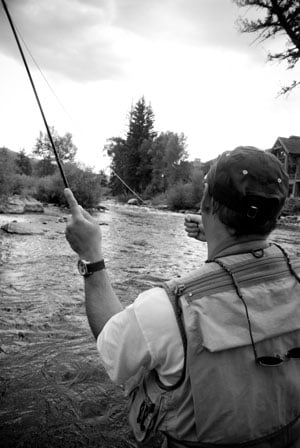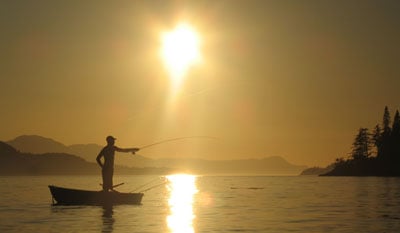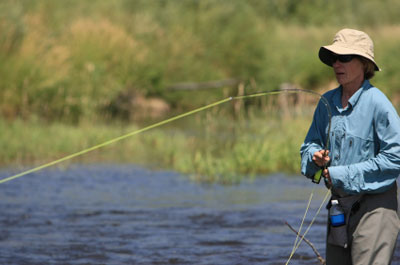Fly Fishing Strategy Tips
Choosing Flies

Size Matters When choosing trout flies, the relative importance of fly characteristics in your selection, in order, should be: size, shape, color, and action (for stripped flies). In saltwater, action is often more important than exact size and shape.
Dropper Flies or Tandem Rigs Dropper flies are a trout angler’s secret weapon. A simple dropper rig can be made by tying a small nymph onto 14-18 inches of tippet material tied to the bend of a dry fly. If the trout takes the nymph, the dry fly serves as your indicator. Nymphs can also be tied in tandem, enabling you to find out which nymph is working better.
Wet vs. Dry A fly’s construction determines whether it will float above the surface (dry flies), ride partially or completely submerged (emergers), or sink (nymphs and streamers). Fish expect their food sources to be in a particular part of the water column, and knowing where that is is important key to good fly selection.
Fly Color: Think Seasonal Don’t know where to start with your fly selection? Think first of seasonal color patterns. Early spring, late fall, and winter flies tend to be darker, matching the colors of their environment. Lighter flies typically appear in warmer weather.
Imitation vs. Flattery Fishing flies can be either impressionistic or exact imitations, and their effectiveness often depends on how selective the fish have become due to food availability, weather conditions and fishing pressure.
Think Subsurface for Trout At least two-thirds of the diet of trout is made up of subsurface food sources. Even if you prefer dry fly fishing, knowing what nymphs, larvae and crustaceans are available beneath the surface with help you decide on fly selection.
Stalking Fish
Approach Outside the Cone of Visibility When stalking trout, approach from behind or stay low if approaching from the side or front, since the height of objects is exaggerated in the fish’s perspective. And remember that fish that are submerged can see you from farther away than fish that are close to the surface, due to the refraction of light by the water’s surface.
Think Position First Before you try a very difficult cast to a fish make sure that there is no way to get yourself into a better position. Putting yourself where you can make an easier cast and get a better drift is always time well spent.

Timing and Planning The biggest difference between trout fishing and fly fishing in saltwater is that in the ocean, fish are almost always moving and give you little time to strategize. When trout fishing, take advantage of the time you have to consider what the fish are eating and what position will give you the best, drag-free presentation. In saltwater, the challenge is to stay attentive and ready over long periods while hunting fish.
Walk Softly Fish are as sensitive to sound and vibration as they are to visual warnings. Walking lightly on the bank and wading without pushing water are important tactics. In saltwater, noisy or rocking boats and slamming cooler lids scare fish.
Prospecting and Blind Casting While prospecting in fresh water, fish the close water first. A common mistake is to cast over fish in the excitement of making a long cast. In saltwater, longer casts are usually better unless you are fishing to mangroves or a shoreline, where structure and changes in current matter most.
High Water During high water, fish often seek out the calmer current near the bank. Fish the slower, bank-side water from land before wading in.
Learning to See Fish Learn to see fish underwater by watching a released fish swim away. It will provide you clues about which parts of a fish are visible and which are not. Watch for for even the slightest bulge when looking for rising trout, and in saltwater “nervous water,” or water that has a slightly different surface texture, may indicate fish locations.
Sharing the Water On-the-water manners are simply summarized: if in doubt, err on the side of etiquette, and learn the local customs. Though on most trout streams anglers fish upstream, some rivers are best fished downstream. And while 25 yards may be acceptable separation on a spring creek, 100 yards may be the bare minimum on many major rivers. Fish density, the size of the water, and custom all play a part in determining what is acceptable. It pays to be patient and polite and be sure you are not moving into water that another angler is planning to fish.
Presentation
Drag is a Drag “Drag” is the number one problem in most presentations of flies to trout, whether fishing with dry flies, emergers or nymphs. Before changing flies, consider whether you are making drag-free presentations.
Ideas for Drag-Free Presentations Having trouble with drag? Changing to a lighter or more supple tippet material, lengthening your leader and tippet, and tying your fly on with a loop knot can all help reduce drag. And sometimes tying on a fly that is more visible helps you to see drag that you might otherwise not notice.
Leader Length Nine-foot leaders are the standard for both fresh- and saltwater fly fishing. But some situations — for example when fishing small dry flies on still water and spring creeks, or when casting to tailing bonefish — 12-foot and even 15-foot leaders are needed. Fishing streamers often requires no more than 7-8 feet of leader material, and shorter leaders make casting heavy flies easier.
Watch Fish Behavior When you spot a feeding trout, don’t immediately start casting. Watch the fish’s behavior to determine what it may be feeding on and the timing of its rises, so that you can put the right fly on the water and have it arrive as the fish begins to look upward again. In saltwater, learning fish behavior — especially the speed at which your target fish takes a fly — is often critical to success.
How Far From the Rise Ring? When casting to a rising fish, don’t target the rise rings. Put your fly at least 3-4 feet in front of where you saw the fish last rise, remembering to give yourself time to thrown an upstream mend into the line if needed. Difficult currents that quickly create drag may require you to throw close to the fish, however, so that the fish sees the fly before it begins to look unnatural.

Feeding Lanes Trout food tends to collect along “seams” or variations in the current. Look for rising fish to hold in or next to these seams where slower water meets faster water, and for opportunistic trout on the edges of gravel drop-offs where water suddenly slows and changes direction.
Read the Water Speed “CFS” stands for “Cubic Feet per Second,” a measurement that matters greatly in the fishability of most freestone and tailwater rivers. While a large river like the Yellowstone might average 10,000 cfs, a mountain stream might average only 10 cfs. Trout feed in currents that are running at 2-6 cfs — usually in the transition areas between faster and slower water, like the tails of pools and the transitional edges between deep and shallow water.
Effective Nymphing Effective nymphing requires two ingredients: drag-free drifts and staying in touch with your fly. Oftentimes this is best achieved by extending your rod and keeping as much line as possible out of the current, or even “high-sticking” with only the leader touching the water.
Get Down with Nymphs When nymph fishing, be sure your fly is getting down to the fish. One or two split-shot may be needed, and keeping your nymph drifting downstream of your leader and fly line help it sink.
Turn Your Nymph into an Emerger If you notice trout taking flies just beneath or in the surface film and don’t have an emerger pattern handy, floatant can be applied to lighter-weight nymph patterns to keep them at or near the surface.
Indicators: Striking Too Late When fishing with indicators, the tiniest pause or movement of the indicator may mean a fish has eaten your nymph. Beginners often make the mistake of waiting for the indicator to “bob” and therefore miss many takes.
Learn to “Read the Rise” Fast current and flies that emerge quickly — like caddisflies — or skitter along the surface cause trout to make loud, splashy rises. Classic rises make dimples in the water and leave behind a few bubbles, indicating feeding on mayfly duns and other flies riding above the surface film. Small dimples that leave no bubbles but sometimes include the dorsal and tail appearing usually indicate emergers or small flies dangling in the surface film. Bulges or swirls are the hardest to see and often indicate a fish feeding just beneath the surface.
“He Missed It!” Trout rarely “miss” a fly. A rise followed by a disturbance in the surface usually means a refusal.
Swing and Lift When swinging wet flies, master the art presenting the fly so that it starts to rise just as it reaches a good lie — a technique known as the “Leisenring lift.”
Straight Lines for Stillwater When casting to trout in the still or very slowly moving water of a lake, pond or large run, make as straight a cast as you can and finish with little slack in your line or leader. As long as no current is causing drag, this will improve your hook-up percentage.
Going Downstream Although classic presentations are typically made upstream to trout, sometimes complicated currents can make good presentations with upstream casts impossible. In those cases, try getting well above the fish and making an S-cast with plenty of slack directly downstream. If done right, your line will straighten (but not your leader) just before the fly reaches the target.
Saltwater Casting Distances Most saltwater fly fishing requires casts of no more than 50 or 60 feet and many fish are hooked when they are 30 feet away. Equally, if not more, important than the distance you can cast: the speed at which you can deliver the fly, your “situational awareness” about the fly line at your feet, and your ability to pick up and make additional casts to the fish if your first cast is off the mark.
Saltwater Stripping When fishing in saltwater, always strip with the rod tip at or near the water’s surface. This guarantees that your retrieve imparts action to the fly, and it ensures that when a fish takes your fly the line will come tight immediately. And remember that if a particular strip is not working, a change in tempo or strip length can work magic, especially if you notice a fish following but not committing.
The “Season” Never Ends Cold weather doesn’t mean an end to trout fishing, only smaller bugs and fewer hatches. But warm afternoons in winter can produce spectacular midge and baetis hatches, and nymphs that match these bugs can be very effective when no fish are rising.
Keep It Sharp Occasionally check your hooks for sharpness while fishing and carry a diamond hone or stone to touch up points that might have struck a rock, the side of the boat or other objects during your casts.
Playing, Landing and Releasing Fish
Thy Rod and Thy Arm When playing fish, think of your arm as an extension of the fly rod. Keeping your rod tip high and arm extended above your head provides additional shock-absorption and makes it less likely that your line or leader will touch an underwater obstacle. Larger fish, especially once they are closer, can be beaten more quickly with sideways pressure, but extending your rod arm when they surge away is good practice.
Avoiding Break-Offs Sudden movements of a fish or setting the hook too hard are more likely than a steady hard pull to cause a tippet to break, because the tensile strength of monofilament and fluorocarbon is greatly reduced by high-speed stretching.
Don’t Touch That Drag Don’t adjust your drag during the playing of a fish unless you are very familiar with the drag system. It’s almost impossible to measure the amount of pressure your drag is adding once a fish is on the line.
Practice for Big Fish If you plan on fighting big fish, first learn how much pressure you can put on a fish by tying your tippet to a fence post or other stationary object, reeling the line tight, palming the spool, and pulling as hard as you can without breaking the tippet. Practice keeping your rod at a 45-degree or lesser angle to the fish to ensure that you do not break the rod and that you are pulling with the bend in the butt of the rod and not the tip.
The Saltwater Strike In saltwater, swinging your rod tip up or to the side when you see fish take the fly — especially if you are not first tight to the fish — can cause the hook to pull and make it much harder to get a good hook set. Unless a fish is speeding toward you as it east the fly, feel for the fish with your stripping hand first, then raise the rod only after putting tension on the line with your stripping hand.

Play and Land Fish Quickly Always play and land fish as quickly as you can, but especially in warmer water, when additional stress may prevent a released fish from surviving. Most trout prefer water that is 50-68 degrees fahrenheit, and brook trout and cutthroats prefer even colder water. If you know that the water where you are trout fishing is 70 degrees, pay particular attention to releasing fish quickly, and if the water is 75 degrees or higher, simply don’t fish. Bass and saltwater fish are more tolerant of heat, but you should take special care in reviving any fish that is landed in water over 90 degrees.
Releasing Fish You don’t usually need to handle a fish or take it out of the water in order to remove a hook or take a picture. Remove flies with forceps or a similar device, and use a net rather than your hands if you must control the fish.
Check Your Bait Especially when casting often or in strong winds, examine your tippet and fly every four or five casts. Wind-knots (overhand knots) weaken your tippet by at least 50 percent, and tippets can get tangled in your fly or even knotted around the hook bend — things you won’t notice on a fly that is 40 feet away. Also check the action of the fly on the surface or in the water next to you; trout flies that don’t float well or straight and saltwater flies that “foul” (have materials wrapped around the hook bend) often prevent fish from eating a well-chosen fly.











